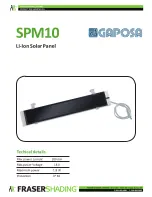
Yingli Solar G/G Modules, Installation and User Manual
page 5
Figure 10: Grounding screw assembly detail
Option B: Racking manufacturer integrated grounding methods
Yingli Solar PV modules can be grounded by bonding PV modules to a grounded
racking system. Integrated grounding methods must be certified for grounding
PV modules and must be installed in accordance with the specified instructions
of their respective manufacturers.
Option C: Additional third-party grounding devices
Yingli Solar PV modules can be grounded using third-party grounding devices so
long as they are certified for grounding PV modules and the devices are installed
according to the manufacturer’s specified instructions.
M E C H A N I C A L I N S TA L L AT I O N
Yingli Solar PV modules have been certified for a maximum positive design
loading of 3600 Pa, and negative design loading 1600 Pa, with 1.5 times safety
factor.
Never steps on the module or put heavy objects on it to avoid microcracks of the
cells.
Mounting structures and other mechanical parts must be designed and approved
to withstand the design wind and snow loads apply for a particular site. Yingli
Solar PV modules must not be subjected to forces from the substructure,
including forces caused by thermal expansion.
In order to maintain the fire class rating, the distance between the PV module
back surface and the roof surface shall be at least 100 mm. This spacing also
allows air flow to cool the PV module. Install PV modules with a minimum spacing
of 10 mm between neighboring modules to allow for thermal expansion.
The fire rating of a PV module is valid only when mounted in the manner specified
in the mechanical mounting instructions of this installation manual.
The installation shall follow the instructions below. If the installation method is
different from this manual, please contact Yingli engineers for approval. Please
find the installation drawings in the “Module Supplement”.
Frameless PV Module Mounting Mode
•
Clamps selection
The manufacture of the clamp is responsible for providing an appropriate clamp
and installation manual. Clamps length shall not be less than 120 mm, and the
installation depth shall be greater than 12 mm. In order to protect the glass,
clamps shall have two protective layers of EPDM rubber, and the thickness of
each layer of the rubber shall not be less than 3 mm. Minimum dimensions are
shown in figure 11
.
Figure 11: Detail of a clamp
•
Bill of material
Table 3: Installation accessories
•
Mounting method
Step 1:
Place the clamps on the support beams at correct positions according to
the module size. The exact values can be found in the “Module Supplement”
according to the module size (see Figue 13).
Figure 13: Primary fixation clamp
Step 2:
Insert the module into the clamps and tighten the bolts (It’s recommended to fix
the clamps by M8 screws and tighten the screw with 16 N•m ~ 20 N•m torque,
see Figure 14).
Figure 14:
Tighten
clamp
Successively fasten clamps and connect frameless G/G modules (see Figure 15).
Figure 15: Frameless G/G array
Name
Dimesion (mm)
Material
Upper clamp
Length * Width
120×50
Aluminium alloy 6063 T5
EPDM rubber
Lower clamp
Length * Width
120×60
Aluminium alloy 6063 T5
EPDM rubber
Beam
Width * Height * Wall thickness
41×41×2.0
Galvanized steel
Nut
Suitable for M8 screw
Plastic
SUS 304
Inside hexagonal bolt
M8 screw
Spring washer
Flat washer
SUS 304
Figure 12: Installation accessories
Upper Clamp
EPDM Rubber
Lower Clamp
Inside Hexagonal Bolt
Beam
Nut
C type steel installation





























